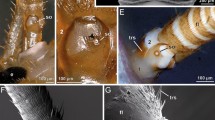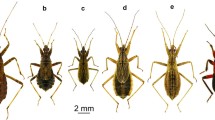Summary
-
1.
With the onset of apolysis the external extracellular space of the sensilla opens into the exuvial space. The cuticular sheaths and the ciliary structures become lengthened. The cuticular sheaths delimit and protect the modified cilia against the exuvial fluid.
-
2.
The old receptor apparatus stays in contact with the sensory cells above the cuticular sheath until ecdysis. In the formation of the new cuticle, the cuticular material is deposited around the cuticular sheath, thereby forming channels, called the ecdysial canals. These also remain intact after the cuticular sheath and the modified cilium become torn away.
-
3.
The ecdysial canal of the filiform and club-shaped hairs is situated above the base of the hair; the ecdysial canal of the campaniform sensilla is in the middle of the cuticular cap.
-
4.
A second and new tubular body is already formed under the new cuticle in the modified cilium before ecdysis. The old tubular body disappears during ecdysis. The sensilla therefore can probably perceive stimuli until the time of ecdysis through the old tubular body and there-after through the new tubular body.
-
5.
Mechanoreceptive sensory hairs and campaniform sensilla are homologous structures. The internal enveloping cell (H 1) lays down the cuticular sheath. The middle enveloping cell (H 2) is the trichogen cell, and the external one (H 3) is the tormogen cell.
Zusammenfassung
-
1.
Mit einsetzender Apolysis öffnet sich der äußere Liquorraum der Sensillen in den Exuvialraum. Die cuticularen Scheiden und die in ihnen enthaltenen Ciliarstrukturen werden verlängert. Die cuticularen Scheiden grenzen die Sinnescilien gegen die Exuvialflüssigkeit ab.
-
2.
Über die cuticularen Scheiden stehen die alten rezeptorischen Apparate mit den Sinneszellen bis zur Ecdysis in Verbindung. Bei der Bildung der neuen Cuticula wird das Cuticulamaterial um sie herum abgelagert. Dadurch entstehen Kanäle, die wir Häutungskanäle nennen. Sie bleiben auch nach der Ecdysis erhalten, wenn die cuticularen Scheiden und die Sinnescilien hier abgerissen sind.
-
3.
Der Häutungskanal der Faden- und Keulenhaare liegt über der Haarbasis, der der campaniformen Sensillen in der Mitte der cuticularen Kuppel.
-
4.
Im Sinnescilium wird bereits vor der Ecdysis unter der neuen Cuticula ein zweiter, neuer Tubularkörper gebildet. Der alte Tubularkörper geht bei der Häutung verloren. Dadurch können die Sensillen wahrscheinlich bis zur Häutung (alter Tubularkörper!) und sofort nach der Häutung (neuer Tubularkörper!) Reize wahrnehmen.
-
5.
Mechanorezeptorische Sinneshaare und campaniforme Sensillen sind homologe Bildungen. Die innere Hüllzelle (H 1) legt die cuticulare Scheide an. Die mittlere Hüllzelle (H 2) ist die trichogene und die äußere Hüllzelle (H 3) die tormogene Zelle.
Similar content being viewed by others
Literatur
Adams, J. R., Holbert, P. E., Forgash, A. J.: Electron microscopy of the contact chemo-receptors of the stable fly, Stomoxys calcitrans (Diptera: Muscidae). Ann. ent. Soc. Amer. 58, 909–917 (1965).
Altner, H., Ernst, K.-D., Karuhize, G.: Untersuchungen am Postantennalorgan der Collembolen (Apterygota). I. Die Feinstruktur der postantennalen Sinnesborste von Sminthurus fuscus (L.). Z. Zellforsch. 111, 263–285 (1970).
Bairati, A.: Structure and ultrastructure of the male reproductive system in Drosophila melanogaster Meig. 2. The genital duct and accessory glands. Monit. Zool. Ital. (N. S.) 2, 105–182 (1968).
Barth, F. G.: Der sensorische Apparat der Spaltsinnesorgane (Cupiennius salei Keys., Araneae). Z. Zellforsch. 112, 212–246 (1971).
Blaney, W. M., Chapman, R. F.: The anatomy and histology of the maxillary palp of Schistocerca gregaria (Orthoptera, Acrididae). J. Zool. 157, 509–535 (1969a).
—: The fine structure of the terminal sensilla on the maxillary palps of Schistocerca gregaria (Forskål) (Orthoptera, Acrididae). Z. Zellforsch. 99, 74–97 (1969b).
Borg, T. K., Norris, D. M.: Ultrastructure of sensory receptors on the antennae of Scolytus multistriatus (Marsh.). Z. Zellforsch. 113, 13–28 (1971).
Chevalier, R. L.: The fine structure of campaniform sensilla on the halteres of Drosophila melanogaster. J. Morph. 128, 443–464 (1969).
Corbière-Tichané, G.: Ultrastructure de l'équipement sensoriel de la mandibule chez la larve du Speophyes lucidulus Delar. (Coléoptère cavernicole de la sous-famille des Bathysciinae). Z. Zellforsch. 112, 129–138 (1971).
Ernst, K.-D.: Die Feinstruktur von Riechsensillen auf der Antenne des Aaskäfers Necrophorus (Coleoptera). Z. Zellforsch. 94, 72–102 (1969).
Foelix, R. F.: Structure and function of tarsal sensilla in the spider Araneus diadematus. J. exp. Zool. 175, 99–124 (1970).
Gnatzy, W.: Struktur und Entwicklung des Integuments und der Oenocyten von Culex pipiens L. (Dipt.). Z. Zellforsch. 110, 401–443 (1970).
—, Schmidt, K.: Die Feinstruktur der Sinneshaare auf den Cerci von Gryllus bimaculatus Deg. (Saltatoria, Gryllidae). I. Die Faden- und Keulenhaare. Z. Zellforsch. 122, 190–209 (1971).
Hsü, F.: Étude cytologique et comparée sur les sensilla des insectes. Cellule 47, 5–60 (1938).
Kendall, M. D.: The anatomy of the tarsi of Schistocerca gregaria Forskål. Z. Zellforsch. 109, 112–137 (1970).
Moeck, H. A.: Electron microscopic studies of antennal sensilla in the ambrosia beetle Trypodendron lineatum (Olivier) (Scolytidae). Canad. J. Zool. 46, 521–556 (1968).
Moran, D.T., Chapman, K. M., Ellis, R.A.: The fine structure of cockroach campaniform sensilla. J. Cell Biol. 48, 155–173 (1971).
Moulins, M.: Les cellules sensorielles de l'organe hypopharyngien de Blabera craniifer Burm. (Insecta, Dictyoptera). Étude du segment ciliaire et des structures associées. C.R. Acad. Sci. (Paris) 265, 44–47 (1967).
Moulins, M.: Les sensilles de l'organ hypopharyngien de Blabera craniifer Burm. (Insecta, Dictyoptera). J. Ultrastruct. Res. 21, 474–513 (1968).
Peters, W.: Die Sinnesorgane an den Labellen von Calliphora erythrocephala Mg. (Diptera). Z. Morph. Ökol. Tiere 55, 259–320 (1965).
Richard, G.: L'innervation sensorielle pendant les mues chez les insectes. Bull. Soc. Zool. France 77, 99–106 (1952).
Richter, S.: Die Feinstruktur des für die Mechanorezeption wichtigen Bereichs der Stellungshaare auf dem Prosternum von Calliphora erythrocephala Mg. (Diptera). Z. Morph. Ökol. Tiere 54, 202–218 (1964).
Schmidt, K.: Die Entwicklung der Scolopidien im Johnstonschen Organ von Aëdes aegypti während der Puppenphase. Verh. Dtsch. Zool. Ges. Heidelberg 1967. Zool. Anz., Suppl. 31, 750–762 (1968).
—: Die campaniformen Sensillen im Pedicellus der Florfliege (Chrysopa, Planipennia). Z. Zellforsch. 96, 478–489 (1969a).
—: Der Feinbau der stiftführenden Sinnesorgane im Pedicellus der Florfliege Chrysopa Leach (Chrysopidae, Planipennia). Z. Zellforsch. 99, 357–388 (1969b).
Sihler, H.: Die Sinnesorgane an den Cerci der Insekten. Zool. Jahrb., Abt. Anat. u. Ontog. Tiere 45, 519–580 (1924).
Slifer, E. H.: Sense organs on the antennal flagella of earwigs (Dermaptera) with special reference to those of Forficula auricularia. J. Morph. 122, 63–79 (1967).
—: The structure of arthropod chemoreceptors. Ann. Rev. Entomol. 15, 121–142 (1970).
—, Prestage, J. J., Beams, H. W.: The fine structure of the long basiconic sensory pegs of the grasshopper (Orthoptera, Acrididae) with special reference to those on the antenna. J. Morph. 101, 359–397 (1957).
—: The chemoreceptors and other sense organs on the antennal flagellum of the grasshopper (Orthoptera; Acrididae). J. Morph. 105, 145–191 (1959).
—, Sekhon, S. S.: Fine structure of the sense organs on the antennal flagellum of a flesh fly, Sarcophaga argyrostoma R.-D. (Diptera, Sarcophagidae). J. Morph. 114, 185–207 (1964).
Smith, D. S.: The fine structure of haltere sensilla in the blowfly, Calliphora erythrocephala (Meig.), with scanning electron microscopic observations on the haltere surface. Tissue & Cell. 1, 443–484 (1969).
Stuart, A. M., Satir, P.: Morphological and functional aspects of an insect epidermal gland. J. Cell Biol. 36, 527–549 (1968).
Thurm, U.: Mechanoreceptors in the cuticle of the honey bee: fine structure and stimulus mechanism. Science 145, 1063–1065 (1964).
- Untersuchungen zur funktionellen Organisation sensorischer Zellverbände. Verh. Dtsch. Zool. Ges. Köln 1970, S. 79–88 (1970).
Uga, S., Kuwabara, M.: The fine structure of the campaniform sensillum on the haltere of the fleshfly, Boettcherisca peregrina. J. Electron Micr. 16, 304–312 (1967).
Walcott, Ch., Salpeter, M. M.: The effect of molting upon the vibration receptor of the spider (Achaearanea tepidariorum). J. Morph. 119, 383–392 (1966).
Zacharuk, R. Y.: Exuvial sheaths of sensory neurones in the larva of Ctenicera destructor (Brown) (Coleoptera, Elateridae). J. Morph. 111, 35–47 (1962).
Author information
Authors and Affiliations
Additional information
Mit Unterstützung durch die Deutsche Forschungsgemeinschaft.
Rights and permissions
About this article
Cite this article
Schmidt, K., Gnatzy, W. Die Feinstruktur der Sinneshaare auf den Cerci von Gryllus bimaculatus Deg. (Saltatoria, Gryllidae). Z. Zellforsch 122, 210–226 (1971). https://doi.org/10.1007/BF00337630
Received:
Issue Date:
DOI: https://doi.org/10.1007/BF00337630




